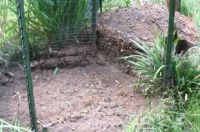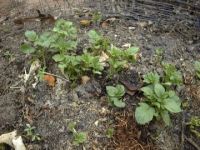The
first bin will fill up and become gorgeous compost, brown and crumbly, by summerís end.
What do we do
with our kitchen scraps in fall and winter?
Maybe
even more important, what
do we do with the many garden plants at the end of
the summer season?
 And
that's
why we have a second bin. An empty second bin.
And
that's
why we have a second bin. An empty second bin.
We pile those dead plants from the summer garden into the bin. Not the thick stems and roots (too hard to decompose), and we remember to chop the rest into smaller pieces with the sharpened shovel. We finish by covering the greens with dirt.
Then comes the hard part: Wait. Until. Spring.
That's all we have to do.
Experts advise turning the compost over every few weeks. In fact, they recommend 3 bins, constantly rotating compost from one bin to another.
If
you try to do this rotating, you will abandon composting .
You will find it's way
too hard, both in time and on your lower back.
.
You will find it's way
too hard, both in time and on your lower back.
Instead, do no more than keep the top of the bin covered with earth, keep it moist, and keep feeding it until it's full.
The only maintenance needed is to occasionally pull sprouts that grow like crazy in the terrific dirt of our compost when it's been too long since our last visit. (Photo at right.)
next: Storing the compost